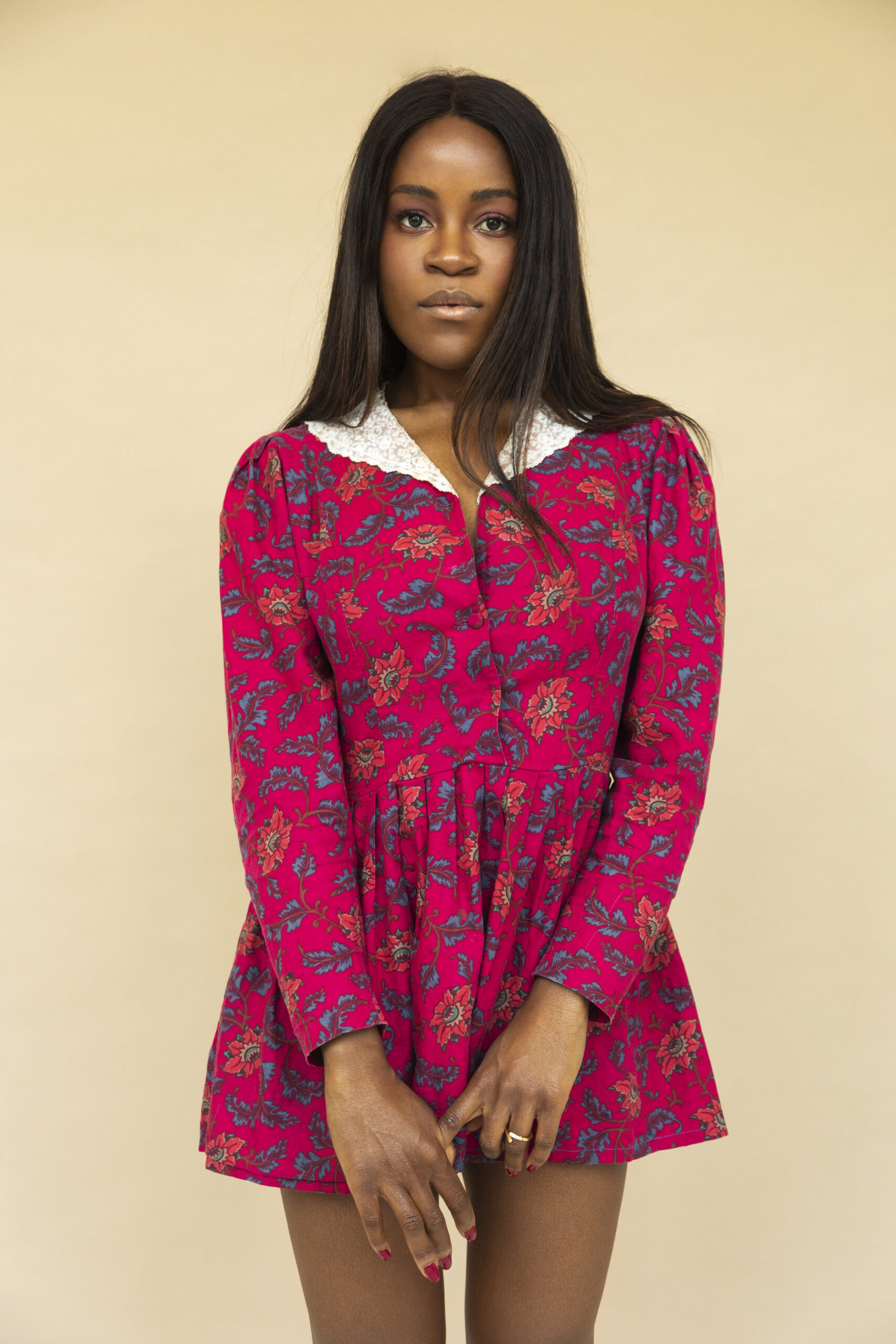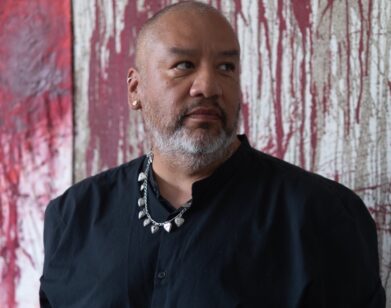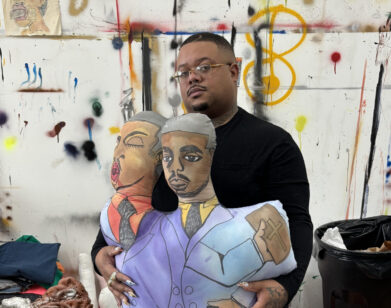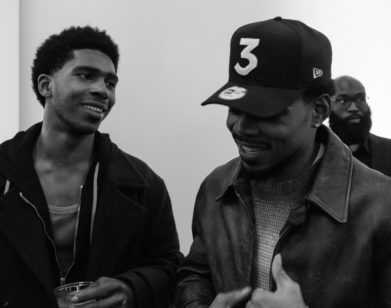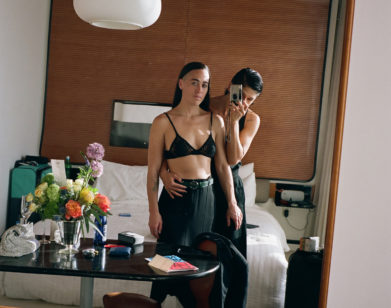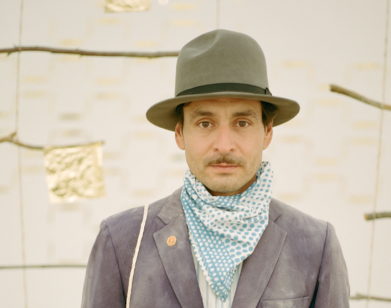VENICE
Meet Aindrea Emelife, the Curator Bringing Nigerian Art to the Venice Biennale
Aindrea Emelife’s 2022’s exhibition Black Venus is a great entry point to the writer and historian’s curatorial philosophy. Black Venus featured the work of 19 international artists who traced the history of black women, exploring the art world, identity and history, while examining where each starts, ends, and converges. It is this type of thinking that flips what we know about art and history on its head, and which Emelife will bring to the 2024 Venice Biennale, where she will be hosting the prestigious festival’s second-ever Nigerian pavilion.
At age 20, Emelife wrote her first column for the Financial Times, in which she argued that “surrealism is so much a part of our visual vocabulary that it is almost overlooked.” She has hardly stopped since. With a degree in Art History from The Courtauld Institute of Art and nearly a decade’s worth of experience, she is part of a very small group of Black women curators in the UK who contextualize and spotlight Black art and Black history. Today, while writing and researching between Europe and Africa, she is the curator of modern and contemporary art at the recently-opened Edo Museum of West African Art (MOWAA) in Benin City, Nigeria, where the famed Benin bronzes now call home after their repatriation late last year.
Earlier this summer, Aindrea and I got together to talk about scouting talent, the origins of her interest in art and history, and how she’ll prepare for next summer’s Venice Biennale.
———
AINDREA EMELIFE: How are you doing?
DESMOND VINCENT: I’m pretty good. Congratulations on getting to host the Nigerian pavilion for the municipality. I can’t imagine how that feels.
EMELIFE: Yeah, it’s great. It’s a huge undertaking, so I’m trying to make sure that it’s as good as it can be. I’m putting all of my effort and energy and excitement and research into this because it’s extremely important. As you know, there’s not a great legacy of African pavilions at Venice [Biennale]. So there’s a great responsibility to make sure it’s executed at an incredible level and that people can really expand what they think about the continent and in particular, Nigeria. I’m really honored and thrilled and the artists are cooking up something amazing, I’m sure.
VINCENT: How did you select the artists for this particular exhibition?
EMELIFE: So the selection process was quite interesting. There’s a couple of different things that I tried to consider. Firstly, the perception of West African art or Nigerian art is quite singular in many people’s minds. I think they attach the idea of Black figuration and bright colors, which I guess has dominated the market scope. But there’s so much more, so I want to ensure that the list wasn’t a list that people may have predicted based on a singular monolithic idea of what Nigerian art is. So I set out to ensure that sculpture and installation is represented, but also new media and art that ebbs into the world of the technological or digital as well. And things like photography or video are important, because Nigeria’s such a young nation. Over 70% of Nigerians are under 30. Then I also started to think about the cross-generational approach. Obviously there are some younger artists, but there are artists like Ndidi Dike, who have been making work steadily for a long time and is receiving the deserved recognition now, and people like Yinka Shonibare, who has been making work that looks at Nigerian identity in a similar way that I do as a diaspora. Obviously I can’t represent every tribe that exists, but there is an artist from the north, like Fatimah Tuggar. There are obviously Igbo artists, there’s Yoruba artists. I’m both Igbo and Yoruba, so I can be unbiased hopefully, and make sure that there’s a balance. I thought it important for the Venice audience to understand the many different pockets of history and identity in Nigeria as well. And I hope through the writing and through some of the curation that the sort of multifaceted nature of what Nigeria is can be told. One other thing that’s important to notice is that some artists are Nigerian artists, some of them are diaspora artists that also work and interact with Nigeria. And I thought it would be a nice and important contribution to have a mixture of both to show how global we are.
VINCENT: You mentioned how people from the outside view African art as a sort of monolith, as a particular style. Why do you think that is?
EMELIFE: I think that it’s driven a little bit by the market. I think when there’s been many different watershed moments in the last couple of years in terms of the wider world waking up to West African art, and then that sort of knee-jerk reaction then sort of coincided with the rise of, I guess, Black figuration or figurative art. And when that happened, when there was this rise of great artists who were making work in this field, people’s limited knowledge of the artworks allowed them to just typify it by just this one practice. And a lot of people assume that we didn’t have a Modernist period or we weren’t making work in the 60s or the 40s or the 70s, and I think that disjointedness of understanding is one of the reasons. They used to make bronzes, they used to make masks, then, somehow, nothing happened, and then now they’re doing this, which is of course incredibly false. There was this moment when I think everyone thought, “Oh, it’s just pink backgrounds and Black women with Afros.” But there’s so much more.
VINCENT: True. As we were talking about selecting the artists for the Pavilion, I wondered how you scout talent.
EMELIFE: It kind of happens very naturally. I’ve got a lovely network of art historians and artists who are very passionate about this and we have lots of conversations about art we’ve seen, things that we’ve read. What I’m really interested in at the moment is trying to delve into the archives to find the artists that have been lost throughout history, of which there are quite a few. But moving back to the contemporary, you actually don’t need to look that hard. There’s just so many West African artists doing such interesting work. I came across Fatimah Tuggar because she was working on a project in a museum in America, which sent me on a really incredible research journey with Chika Okeke-Agulu, who’s one of the advisors of the museum and who’s been mentoring me a little bit. I discovered how many Nigerian artists are working in different parts of the world, whether it’s France or Vienna or Canada. As a diaspora, I will always think of it as an advantage, not a disadvantage, and it’s an interesting lens to understand two places and see how they are different and how they fuse together. But that being said, it’s really interesting to understand the art scene in Lagos and Benin, which is flourishing at such a massive speed. A lot of people think that cultural infrastructure is state-funded in Nigeria, and it’s not. We just do it on our own backs, mostly. And the fact that everything is thriving, that there are residencies set up by artists, is such a great testament to our optimism, but also our self-sufficiency.
VINCENT: Let’s talk about you for a second. How did you get into art?
EMELIFE: So my parents aren’t arty people. I was a little bit of a black sheep. I always loved art and history from a very young age. I would tell my mother to drag me to museums when I was younger and I found it an interesting way of understanding myself and history. One of the things I was most interested in looking at, ironically given the work I’m doing, was the Benin bronzes, because I was brought up in London. I’d always find it very strange obviously that they were there. I studied art history and was working as an independent curator, and a sort of inner precociousness allowed me to start pitching shows to different museums. And luckily, a few gave me a chance to stage shows, and that sort of allowed me to progress and learn more and build. Then I started doing museum shows at different places. I just finished a show that toured called Black Venus, which was on view at Fotografiska in New York. Then it went to the Museum of African Diaspora in San Francisco, and now it comes in London to Somerset House in July. And that show was looking at the history of the Black women throughout art. Again, I’m very interested in topics that relate to histories that have been underrepresented, so that was a really meaningful show to curate. And now I’m working on this Pavilion and I have joined MOWAA [Edo Museum of Western African Art], which is an incredible opportunity to build an institution from the beginning. I think what we want to do with MOWAA could essentially be a blueprint for museums on the continent. And it’s exciting to be able to transfer my curatorial experience and my art historical knowledge and really shift the needle in terms of how West African art is perceived globally.
VINCENT: I was really curious about the Black Venus project. That was really, really fun to look into. What was the light bulb moment for you?
EMELIFE: Black Venus was something that I’d been thinking about for a long time. It very directly obviously relates to my own identity as a Black woman. My mother told me the story about Hottentot Venus from quite a young age. I was maybe about eight. That story stuck with me for a long time and I became very interested in how Black women have moved throughout the world and been perceived. When I underwent the research for the exhibition, which is still very ongoing as I’m now working on a book about this topic, I came across so many different Black female figures in art history that have been lost. And in doing that, I found it interesting to understand how they were then portrayed either in the contemporary sense by new artists and in the historical sense, often by white male artists. One great example is an artist called Jeanne Duval, who was [Charles] Baudelaire’s mistress, but was painted by a few of the Impressionists. But now contemporary artists like Maud Sulter and Mickalene Thomas and Lorraine O’Grady create new artworks that allow them to reclaim Black female agency by restaging these images, but also painting or drawing or photographing her back into artistry, but by the Black woman gaze.
VINCENT: In your career, what were some early wins that made you feel more confident and realize, “Oh, this is a path I want to go down on?”
EMELIFE: I think a lot of things have been very serendipitous. I was very fixed on being in art history from a very early age. But carving a career as a curator is incredibly difficult. What I try to do is lean into some of my differences. I looked to people like Thelma Golden, Okwui Enwezor. Growing up, there wasn’t great visibility of people that were doing this role. So I think that the confidence to really go for it and sort of carve my own path comes from believing that there is always a different way to perceive things. And luckily, the art world is now very interested in new perspectives, so the timing is brilliant. So now, at this juncture, between trying to present this Black Venus project, and also working towards creating a new museum in Africa and doing a national pavilion, there’s something that runs through all those projects, which is the idea of trying to do something differently and show people that there’s more to art or about Africa than we’ve been told. And in order to find that, we need to prioritize different people telling those stories. Otherwise, we all just get the same history over and over and over again.
VINCENT: What’s been your experience navigating the art world as a Black woman?
EMELIFE: I think the difficulty or advantage is visibility. In the U.K., there’s not a large group of us. As a Black woman curator, I’m instantly identifiable. If I walk into a room and I’m talking to people and they’ve met me, they’ll know I’ve arrived, just by way of scanning. So that means that there’s a lot of pressure, because people will have that memory and will be looking more closely. I think that the interesting point when it comes to perception and trying to be taken seriously is proving that my youth or my womanhood or my Blackness, or all three of those things, is a positive rather than a negative. But at this point, having worked as a curator for quite some time, and because the art world is changing and because people want something different, it’s become much easier. I speak to other academics who have been doing the same work and a few decades ago people were more rigid and they didn’t want to listen. And so I feel very fortunate that the work that I’m looking to do, whether as an artist historian, writing books, or curating new shows, is at least landing on ears that are willing to contemplate and to listen, because that just makes the job more exciting. It’s never been just me, and it’s never been about me. It’s about ensuring that we really harness this as a transformative moment to really understand the world better. We need more artists. We need more writers. We need to sustain this on an infrastructure level, as well as the art that goes onto the walls. So I hope that I can use some of the teething and learning points throughout my career to help and develop the future as well.
VINCENT: I love that. How would you summarize what you’d like the impact of your career to be?
EMELIFE: What would make me happy would just be seeing more creative curatorial programming with different voices. I’d be excited to see some of the first semblances of my research inspire others to continue this research path, which is Nigerian African Modernism. I really want shows to travel to Africa, and that’s one of the reasons why I think it’s important that the Nigerian Pavilion travels back to Nigeria. As great as it is to have African shows in the West, I start to wonder why we aren’t seeing the rest of the art world in Africa. That is something I’m really trying to champion. And I think that the work that MOWAA does will maybe be the blueprint for this sort of circulation. Seeing that sort of a cultural exchange, and being part of that, would be the most fulfilling thing. I don’t want the projects I do to be in the service of adding lines to my biography. I don’t think that’s important as a curator.

